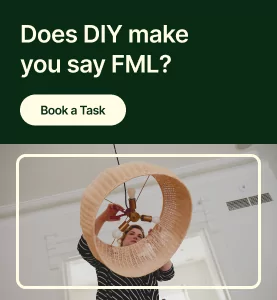Doors
Taskers who have done a lot of Home Improvements tasks involving doors have noted that most frequently, the issue is that there are doors that don’t stay closed, or are catching/out of alignment with the frame.
Door functionality is subject to things outside of your control too—for instance, wooden doors react to wet weather and can expand or contract. There are shifts that happen to building structures that can also impact door frames, especially in older homes or in homes located in areas with seismic activity. Let your client know if you believe the repair may not work perfectly, but that you’ll do your best to make it functional.
James C. told us that he learned how to install door handles the hard way—by messing up! He once drilled an erroneous door handle cutout because he had put the cutting template in the wrong location. While Taskrabbit’s fantastic Support was able to come to the rescue for him and his client alike, this experience taught him to be more careful and to practice at home first.
Determine if the door latch is not catching because it’s too high or too low, or if it’s front to back. That will tell you how to approach the repair. High/low issues can usually be resolved with shims. Front to back usually requires the strike plate to be adjusted. Thanks to Greg S. for these pro tips!
Scoping the task:
- Are the doors new or old?
- What material is the door?
- Is it an interior or exterior door?
- Is the door pre-hung?
- Is the door on a track?
- Do the doors need to be cut for knobs?
- Do you have all the parts that are needed for the task? If not, will you need me to purchase them on your behalf?
Special tools:
- Jig to cut handle hole
- Router
- Wood chisel set
- Plastic door shims for 3 & 4 screw hinges
- Mr. Grip screw hole repair kit
- Supply of various length and size wood screws
Door locks
If you have a logical mind, locks could be your next great challenge; the mechanical parts are very straightforward and once you get a few lock repairs under your belt, it will become easy for you to identify the issue and resolve it.
Remove the small screw in the doorknob/handle with a small Allen key, pull out the handle and see the square bit inside. If the handle turns but the lock doesn’t work, it’s easy to identify the issue. If it’s broken, it will need to be replaced. Create your hypotheses. Could the issue be the door frame, and not the lock itself? Asking the right scoping questions will give you a head start!
Scoping the task:
- Ask your client to specify the issue—does the door not close? Does the lock not move?
- Ask the client to send a photo in the Task Chat so you can see the make and model of the lock.
Special tools:
- Drill
- Screwdriver
- Wood chisel
- Hole saw
Cabinets
Many clients find that their kitchen cabinet door hinges come loose. Iulian D. once had what he called a “nightmare task,” when he had to repair someone else’s attempt to secure cabinets directly to a plaster wall with just screws and nothing behind! He removed the cabinets, cut off the plaster, installed timber behind, added new plaster in front, and re-secured the cabinets.
Iulian’s solution is a great example of how properly scoping time estimates with the client is essential to managing expectations. He was able to assess the situation before starting, and let the client know up front that it would be a lot of work. Both Iulian and his client felt satisfied after the task was completed knowing it was done right.
Scoping the task:
- What size are the cabinets?
- What room are the cabinets in?
- Is your cabinet face frame or overlay?
- Do you have the hardware to mount the cabinets to the wall?
- Wall cabinet or floor cabinet?
- Are the cabinets made of wood or another material?
- If the cabinet is to be mounted: Do you know what material the wall is made of?
Special tools for hanging cabinets:
- Hinge cutter
- Level
- Tape measure
- Stud finder (if mounting)
- Drill
- Clamps
- Material for ledger board
- Shims
Another pro tip from Iulian: He brings his own screws and extra parts. If something goes wrong, at least he knows it’s in his control and he can’t blame the supplies. He said, “You’re more of an expert at the parts that you use all the time!” This advice rings true across Home Improvements task types.








